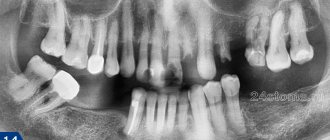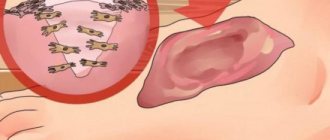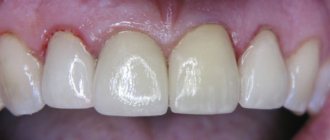Gum inflammation is one of the most common dental problems. The cause of inflammatory processes is often poor oral care and non-compliance with rules and regulations of hygiene, as well as injuries to the mucous membranes, accompanied by a violation of their integrity. It happens that inflammation begins after treatment at the dentist. If a patient’s gums become inflamed after going to the doctor, they should visit the dental office again, since this symptom almost always indicates the need for repeated medical intervention.
Slight soreness and swelling of the gums may be normal after complex dental treatment (for example, depulpation), but these signs should not be of high intensity or last more than 24 hours. Inflammation following extraction should also resolve within 48-72 hours after surgery. In all other cases, it is necessary to find out the cause of inflammation and take timely measures to prevent complications.
The gums became inflamed after dental treatment
Causes of edema
Swelling of the gums is a consequence of penetration of pathogenic bacteria into the soft tissues, causing infection.
Provoking factors:
- tartar formed due to poor oral hygiene;
- advanced form of caries;
- untreated stomatitis;
- infectious diseases of the throat;
- mechanical damage to soft tissues;
- difficult teething;
- immunodeficiency;
- vitamin deficiency (mostly severe lack of vitamin C);
- herpes virus activity;
- allergies to dental drugs or materials;
- development of purulent processes inside the tooth;
- the presence of tumors on the tooth root;
- gum diseases.
Before making a diagnosis, the dentist will definitely prescribe diagnostics to determine the internal state of the tissues, which will more clearly define the clinical picture and identify the main cause of the pathology.
Content:
- Etiology: why gums swell 1.1. Non-inflammatory causes
- The gums are swollen and very painful: the main reasons
- What to do if the gum is swollen after removal 3.1. The most problematic teeth
- Symptoms that require immediate medical attention
- Preventing swelling in the mouth
The most common reasons that force you to seek help from a dentist are toothache and discomfort associated with the condition of the soft tissues of the periodontium.
For example, if the gums are swollen, swelling of the cheek mucosa and even facial asymmetry are observed. Inflammation indicates that it is the cause of the pain, so a visit to the clinic is indispensable. When the gums are swollen, only the dentist will understand what to do first, since this condition occurs in several forms and occurs due to various reasons. By eliminating their influence, it will be possible to relieve inflammation, pain, bleeding, bad breath, strengthen teeth and prevent the development of serious consequences.
Associated symptoms
Often gum swelling is accompanied by other symptoms:
- swelling of the cheek;
- fistula formation;
- tooth pain;
- bleeding gums;
- sensation of a metallic bite;
- redness of the gums;
- discharge of pus from the carious cavity;
- loosening of the crown;
- the appearance of ulcers;
- increase in general body temperature;
- the appearance of white plaque on the gums.
If there are signs of a purulent process, then contacting a dentist should be done immediately. Complications can lead to serious consequences not only for the oral cavity, but also for the entire body.
Swollen gums in an adult: other clinical cases
- Injury to the gums. Thermal and chemical burns lead to tissue damage around the element of the dental system. Symptoms can be expressed in increased bleeding, redness, and plaque.
- Poor quality canal sanitation. Poor canal filling can lead to periodontal abscess and result in swelling of the gums and cheeks.
- Extraction of a dental unit. After tooth extraction, in some cases the gums become swollen. This is especially observed after extraction of the figure eight. Swelling for 2-3 days is considered normal. However, if pain persists for more than three days, you should immediately consult a doctor.
The gums may swell not only after tooth extraction, but also due to an allergic reaction to pharmaceuticals and orthopedic structures. When any pathological process is detected, an immediate search for the problem and its elimination is required. If you do not receive qualified help, this can lead to loose teeth, abscess, otitis media and even the development of a tumor.
Possible dental diseases
In 90% of cases, swelling of the soft tissues around the tooth appears with the development of periodontitis, gingivitis, periodontitis or an abscess. Other possible causes are extremely rare.
Periodontitis
With the development of periodontitis, the inflammatory process affects the bone tissue of the jaw. The cause of the pathology is the penetration of infection of the dental root canals and its spread. Swelling of soft tissues during periodontitis is caused by the accumulation of pus. If left untreated, pus may be released through the resulting fistula. The swelling subsides during this period, but the inflammation cannot be eliminated on its own. Treatment is mandatory.
Gingivitis
A distinctive feature of gingivitis from periodontitis is the development of an infectious and inflammatory process in the soft tissues surrounding the tooth. Swelling of the gums with gingivitis mainly occurs during the period of exacerbation. The swelling of the gums can be so severe that the tissue covers the tooth.
Periodontitis
The development of periodontitis occurs against the background of advanced periodontitis. Lack of treatment provokes a purulent process with a localized abscess area. With a periodontal abscess, a cavity forms under the gum in which pus accumulates. Externally, in addition to edema, a pronounced swelling in the form of a semicircle up to 1–2 cm in size appears on the soft tissue. Treatment is carried out surgically.
When to see a doctor
When a child is teething, his immune system is weakened. Symptoms that parents attribute to teething may be hiding a viral or bacterial infection. Don't wait for it to go away on its own and see a doctor if:
- the child has a temperature above 38.5℃;
- he became lethargic and drowsy;
- refuses food;
- Vomiting and diarrhea began.
So:
- When teeth are being cut, the baby’s gums may be painful and swollen; this is a normal phenomenon; otherwise the tooth cannot pass through the tissues of the jaw and gums;
- When the gums erupt, they look swollen, reddened, then they turn white, and a hole forms in the place of the future tooth;
- You should not use a gel to relieve pain in your baby’s gums unless absolutely necessary; if the pain bothers the child greatly, then choose gels without anesthetics or combination drugs;
- If, against the background of teething, the child has a high fever, he is very restless or, on the contrary, lethargic, refuses to eat, if vomiting or diarrhea begins, consult a doctor.
(0 ratings; article rating 0)
Share Share Share
Treatment methods
Depending on the cause of gum swelling and accompanying pathological processes, the doctor may prescribe conservative treatment, or resort to surgical manipulation or tooth extraction. The clinical picture is determined by the results of examination and radiography.
Conservative therapy
When visiting a dental clinic, a specialist eliminates the cause of gum swelling and then begins to eliminate inflammation, symptoms and associated pathological processes.
The patient may be prescribed drug therapy, including:
- antiviral;
- painkillers;
- antibiotics;
- antihistamines.
Local therapy that has an antiseptic effect is required. The dentist may recommend the use of special ointments or gels, rinsing the mouth with medications or herbal decoctions.
Surgery
The help of surgical dentistry is necessary for certain indications. The need for surgical intervention arises with the development of a purulent process. The specialist will need to open the gum, fistula or root canal to release the pathological fluid. Next, the affected cavity is cleaned, treated with an antiseptic, and treatment of the underlying disease begins. Swelling of the gums can be a sign of a serious pathology that requires tooth extraction. The need for extraction or the possibility of saving the tooth is assessed by the doctor.
First aid for inflammation
It is better to use any medications to combat pathological symptoms after consulting a doctor, since all medications in this group have different compositions and a list of contraindications. At home, you can use various rinses as first aid before going to the dental clinic. They are not recommended for use for more than two days, since the absence of qualified assistance for a long period of time can worsen the patient’s condition and lead to the progression of the pathology.
Calendula decoction with salt
Calendula flowers have a disinfectant, antimicrobial and healing effect
Calendula is one of the most famous medicinal plants. Calendula flowers (marigolds) have a disinfectant, antimicrobial and healing effect, so a decoction of this plant helps to quickly cope with inflammation and speed up the healing of soft tissues. If you add salt to the decoction, you can improve the condition of the gums during purulent inflammation, since any salt perfectly draws out pus and ensures the outflow of exudate.
To prepare a medicine to treat inflammation, you must:
- Pour 100 g of calendula flowers into 700 ml of boiling water and put on low heat;
- cook for 15-20 minutes;
- add a tablespoon of salt and cook for another 5 minutes;
- leave for an hour and strain.
You should rinse your mouth with this decoction 3 to 10 times a day (depending on the degree of inflammation). Symptoms usually become less noticeable on the second day of use.
Bread crumb infusion
Bread crumb infusion is a simple and effective remedy for treating gum inflammation.
If you don’t have medicinal plants at hand, you can use a very simple but effective recipe and prepare an infusion from bread pulp. You can use any type of bread made from rye or peeled flour, as they contain a large amount of minerals and vitamins that have a positive effect on the condition and health of the gums.
Preparing the infusion is very simple:
- break one piece of bread (approximately 50-70 g) into small pieces and place in a shallow container;
- pour 300 ml of boiling water and add half a spoon of salt;
- leave for 5-7 minutes and cool.
You should rinse your mouth with this infusion 3-5 times a day. The product perfectly helps with any inflammatory processes, pain after treatment and tooth extraction, as well as at the initial stage of purulent-infectious processes.
Video - How to treat gum disease
- How to deal with unpleasant odors in the home of a seriously ill person
Pain after complex surgery
One of the most common reasons that the gums hurt where the tooth has long been extracted is incorrect or incomplete extraction. Dental defects leading to this:
- crooked roots: it may not be completely removed, part of it remains and eventually begins to rot;
- fragile tooth: if a tooth falls into pieces when touched with a surgical instrument, one of them may remain in the gum and lead to inflammation;
- the tooth has no outer part left: this situation requires complex surgical intervention; simple extraction is not enough;
- The tooth is embedded deep in the gum tissue.
In all these cases, you can get rid of the pain only by extracting the remains of the tooth from the gums. To do this, usually an incision is made in the tissue, and the gums at the site of inflammation are peeled off from the jaw bone. After this, the remaining teeth are cut out using a drill or divided into parts and removed.
Pain at the site of a dead tooth
It happens that the nerve has been removed from the teeth, but they still hurt. If the nerve is not completely removed or the doctor put too much filling material into the canal, then the pain will not leave you for a very long time and will occur when eating hard, cold or hot foods.
Pain in a dead tooth can appear due to the fact that tissue inflammation has gone too far, and not only the nerve and pulp are affected, but also the bone tissue that surrounded the tooth, as well as due to the use of too aggressive drugs in treating the nerve.
Often, to regenerate tissue at the site of the inflamed nerve, a course of special anti-inflammatory drugs is prescribed. To avoid problems with inflammation when extracting the nerve, it is recommended to first install a temporary filling.
What to do if the gums near the crown become inflamed
Inflammation of the gums near the tooth under the crown is treated based on the original cause that caused it. So, if swelling of the soft tissues appears as a result of trauma to the gums with a brush or due to the chemical components included in the rinses, it is enough to replace oral hygiene products with more suitable ones, and treat the gums themselves with antiseptics.
If swelling of the gums is caused by the development of dental pathology - gingivitis, periodontitis, etc., complex treatment is necessary - professional cleaning, curettage of periodontal pockets, application of anti-inflammatory and wound-healing ointments, injection of vitamins and sometimes antibiotics into the gums.
When flux forms, it is opened and the wound is drained.
If the flux has opened on its own and a fistulous tract has formed, endodontic treatment is carried out (if a crown covers a living tooth or not all root canals are filled) or resection of the apex of the root on which inflammation has formed. If it is presented late, it is not always possible to save the tooth under the crown and then it is removed. To the list of posts
How to get rid of pain at home
If you suddenly begin to experience pain in a place where a tooth is no longer present, it is not recommended to apply warm compresses, wrap the area of inflammation with a warm cloth, or take warm decoctions. Due to heating, suppuration most often occurs, which causes unpleasant consequences.
Cooling the inflamed area helps relieve pain. In this case, you can use ice compresses or just a cool cloth.
A cold compress will help relieve pain and swelling
Folk recipes help relieve inflammation of the flesh at the site of an extracted or dead tooth: a decoction of chamomile, oak bark. You should not intensively rinse the sore spot, as there is a chance to wash out the newly formed blood clot. It's better to just keep the decoction in your mouth for a while.
No folk remedies will help with advanced inflammatory process. Self-medication makes sense only in the initial stages of the disease.











